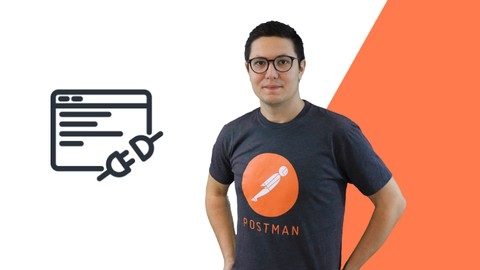API testing is a critical aspect of software development, ensuring that the communication channels between different applications function seamlessly.
By mastering API testing, you can guarantee the reliability, security, and performance of your applications, leading to enhanced user experiences and smoother integration with other systems.
Whether you’re a developer, tester, or simply interested in understanding how applications interact, learning API testing is a valuable skill in today’s interconnected world.
Finding a comprehensive and practical Postman course on Udemy can be a daunting task, given the vast number of options available.
You’re looking for a course that not only covers the fundamentals but also delves into advanced techniques, provides hands-on exercises, and equips you with the skills to confidently test APIs in real-world scenarios.
Based on our in-depth analysis of various courses, we’ve identified Postman: The Complete Guide - REST API Testing as the best overall choice on Udemy.
This course stands out due to its comprehensive curriculum, covering everything from basic API concepts to advanced automation and integration techniques.
The instructor’s clear explanations, practical examples, and hands-on exercises make it an ideal choice for learners of all levels.
However, if you’re seeking a course with a specific focus or tailored to your experience level, we have several other excellent recommendations.
Keep reading to explore our curated list of the best Postman courses on Udemy, catering to different learning styles and goals.
Postman: The Complete Guide - REST API Testing
This Postman course begins with the essentials – installing Postman and understanding how APIs work.
You’ll learn by doing, sending your first request and troubleshooting common hiccups.
You’ll master different HTTP methods like GET to retrieve data, POST to create data, PUT and PATCH to update data, and DELETE to remove data.
As you progress, you’ll become comfortable with key tools like Postman collections for organization, variables for storing information, and query and path parameters for interacting with APIs.
You’ll then dive into API testing with JavaScript.
Think of this as setting up checks to ensure your API is behaving as expected.
You’ll write your first Postman script, learn about variables and data types (like text or numbers), and use assertions to confirm your API is sending the right responses.
You’ll also learn how to organize your tests, reuse them efficiently, and test for edge cases to ensure your API is bulletproof.
Next, you’ll discover how to automate your tests using tools like Postman CLI and Newman.
Imagine running all your API checks automatically!
You’ll even learn how to integrate your tests into a CI/CD pipeline using Jenkins.
This means your tests can run every time you make changes to your API, catching errors early on.
This course doesn’t stop at the basics.
You’ll explore advanced concepts like creating mock servers to simulate a real API, work with different authentication methods to control access to your API, and handle file uploads.
You’ll also learn about real-world use cases, best practices, and advanced features that will make you a Postman pro.
Quick Introduction to Postman and API Testing for Beginners
This course is a great starting point for anyone wanting to dive into the world of API testing.
You’ll begin by mastering Postman, a powerful tool for interacting with APIs.
The course covers the fundamentals of the HTTP protocol and guides you through creating various types of requests, including GET, POST, PATCH, and DELETE.
You’ll learn to organize your requests efficiently using Postman collections and delve into the concept of API authentication to secure your interactions.
The course goes beyond the basics and introduces you to essential techniques like working with query parameters and path variables to make your requests more flexible.
You’ll gain practical experience in handling JSON data, a common format for API responses, and learn to extract relevant information from them.
Automation takes center stage as you progress, equipping you with the skills to write simple JavaScript scripts for automating your tests.
You’ll discover how to use Postman’s built-in features and the Newman command-line tool to execute and manage automated tests efficiently.
POSTMAN API Testing - Step by Step for Beginners
This course is a thorough introduction to the world of API testing with Postman, offering a solid foundation for anyone looking to delve into this critical area.
You’ll start by understanding the basics of Postman, learning how to craft your first API request and exploring essential HTTP methods like POST, PUT, PATCH, and DELETE.
As you progress, you’ll discover how to organize your tests effectively using collections, leverage the power of variables to streamline your workflow, and create and manage environments for different testing scenarios.
The course emphasizes the importance of test automation, guiding you through writing basic test scripts to verify API responses.
You’ll also appreciate the inclusion of data-driven testing, which empowers you to test your API with multiple sets of data.
Learning to debug your tests using the Postman console and implementing authorization will give you the confidence to build secure and robust APIs.
The course seamlessly integrates Postman with command-line tools like Newman and Jenkins, expanding your testing capabilities beyond the graphical interface.
You’ll also learn about advanced features like creating API monitors to track performance over time, generating documentation, and even running your tests remotely.
The inclusion of an introduction to SOAP API testing further broadens your skillset, preparing you to work with various API types.
This comprehensive approach makes this course a valuable resource for both beginners and those seeking to solidify their understanding of API testing with Postman.
Postman - Learn API Testing from Scratch with Live Projects
This course provides a comprehensive introduction to API testing using the Postman tool.
You’ll start by learning the basics of Postman, including its features and how to create collections and HTTP requests.
Next, you’ll dive into working with variables and environments in Postman, which are crucial for automation testing.
You’ll learn how to create variables with different scopes and use them to dynamically generate values in your requests.
The course covers Postman scripting in depth, including different types of scripting editors and how to write assertions for validating responses.
You’ll learn how to run collections as automated tests and validate JSON responses against input data from other APIs.
Data-driven testing is also covered, where you’ll learn how to perform data-driven testing from CSV files and handle error scenarios in your API tests.
The course teaches you how to prepare smart execution workflows using Postman scripting.
You’ll then learn how to handle OAuth 2.0 authenticated APIs, including different grant types and the authorization flow.
There’s a dedicated section on parsing complex nested JSON responses using JavaScript functions like filter, map, and reduce.
The course also covers JSON schema validation, creating mock servers in Postman, and testing SOAP web services with XML response validation.
You’ll learn about Newman, a command-line tool for running Postman collections, and how to generate HTML reports.
Integration with Jenkins is covered, allowing you to run Postman tests through Jenkins and create parameterized jobs to switch environments dynamically.
Team collaboration and version control features in Postman are also explored.
The course includes practical examples like an e-commerce API with session tokens, attachments, and form data, as well as testing GraphQL APIs using Postman.
Optional sections cover JavaScript fundamentals and API testing basics.
REST API Testing, Automation using POSTMAN
This comprehensive course equips you with the skills to confidently test REST APIs using Postman, a widely adopted industry tool.
You’ll begin by mastering the fundamentals of Postman, from installation to exploring its powerful features.
You’ll dive into the heart of API testing by making requests using diverse methods like GET, POST, PUT, PATCH, and DELETE.
The course guides you through crafting requests, interpreting responses, and even creating clear documentation for your APIs.
You’ll learn about crucial concepts like environment variables and collections, which allow you to organize and streamline your API tests.
The course goes beyond the basics, delving into authentication techniques like Basic Authentication, OAuth, and even CSRF, essential for securing your API interactions.
The course doesn’t shy away from advanced topics like scripting in Postman.
You’ll write scripts to automate repetitive tasks, manage variables effectively, and perform assertions to validate the accuracy of your API responses.
You’ll also discover how to leverage Newman to execute Postman collections directly from the command line, offering greater flexibility and control.
Finally, you’ll be introduced to version control using Git and GitHub, essential for collaborative API projects.
The course goes further, showing you how to seamlessly integrate Postman with Jenkins, a popular CI/CD tool, to automate your testing workflow and achieve continuous integration.
To solidify your learning, you’ll apply your newfound expertise to test the Walmart Search API, providing a practical capstone project that demonstrates real-world application.
This course offers a robust path to becoming proficient in API testing with Postman, equipping you with the knowledge and skills to confidently tackle any API testing challenge.
Webservices API Testing with Postman - Complete Guide
This course helps you learn to test APIs like a pro using Postman.
You start with the basics of APIs and web services, understanding how they work and the different types.
The course then focuses on REST APIs, which are commonly used in web development.
You learn about HTTP methods like GET, POST, PUT, and DELETE – these are the actions you perform when interacting with an API.
Next, you dive into Postman, a popular tool for testing APIs.
You’ll learn how to set up Postman, create a Trello account for practice, and even get an authorization token to work with Trello’s API.
The course guides you through using each HTTP method in Postman, providing hands-on exercises to solidify your understanding.
You’ll send requests, analyze responses, and learn to validate the data using JSON Schema, ensuring it’s in the correct format.
As you progress, you discover how to use variables in Postman, making your tests more efficient and reusable.
The course also introduces automated testing, where you learn to create tests that run automatically, saving you time and effort.
Postman Tutorial: Getting Started with API Testing
This course equips you with the essential skills for API testing using Postman.
You will begin by exploring the Postman interface, understanding the differences between the Desktop and Web Apps and discovering how to navigate through the platform with ease.
You will learn to send basic HTTP requests, such as GET, POST, and DELETE requests, allowing you to interact with APIs and retrieve data.
The course emphasizes practical skills, teaching you how to use the History Tab to review your past requests and responses, which is valuable for debugging and troubleshooting.
You will then delve into more advanced request techniques, such as authentication, a crucial aspect of secure API interaction.
You will learn how to send data through headers, work with request parameters to customize your requests, and explore the different body options available for sending various data formats.
You will become proficient in using the Postman Console, a powerful tool for testing and debugging APIs.
As you progress, you will discover how Postman Collections can streamline your workflow by organizing your API requests into logical groups.
This organizational feature simplifies the management and execution of multiple API tests, making your testing process more efficient.
You’ll also master the use of Environments, which enable you to manage variables and create dynamic testing scenarios, ensuring your API tests are robust and adaptable to different scenarios.
Furthermore, the course highlights Postman Workspaces, emphasizing their importance in collaborative API development.
You will understand how Workspaces facilitate teamwork by providing a shared platform for developing and testing APIs, fostering seamless collaboration among team members.
Additionally, you will learn how to leverage useful features like the Scratch Pad, a space for experimenting with code snippets and testing API calls in isolation.
Postman Crash Course | Learn API Testing in 50 minutes
This Postman crash course teaches you how to test APIs, which are like messengers that let different apps talk to each other.
You’ll start by understanding what APIs are and why testing them is so important.
The course then introduces you to Postman, a popular tool for working with APIs.
You’ll learn how to download, install, and navigate Postman, including sending your first request.
You’ll then learn how to work with JSON and XML, two common data formats used by APIs.
You’ll discover how to send different types of requests, add authentication information like passwords, and pass data to APIs.
The course then introduces you to the powerful world of automation, teaching you how to write tests to automatically check if your API is working correctly.
Finally, you’ll learn about data-driven testing, a technique that lets you test your API with lots of different data.
You’ll explore how to use Postman Collections, which are like containers for your tests, and how to run them multiple times with different data sets.








